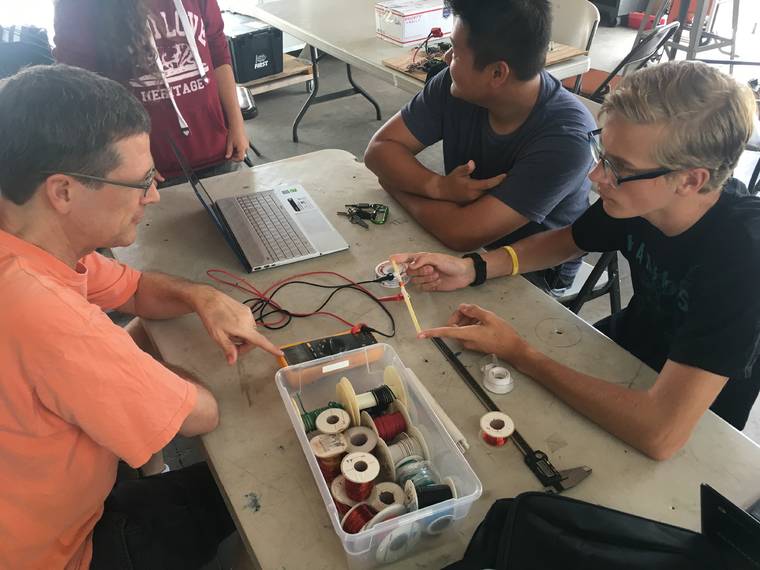KAILUA-KONA — Hunter Patterson wanted to end his time at West Hawaii Explorations Academy last year on a high note.
He was looking to create a senior project that focused on renewable energy. He found the perfect one with WHEA senior Kenichi Furuto.
The two decided to work on creating what they call a KREWD — a Kinetic Renewable Energy Wearable Device. To get the project rolling, they enlisted the help of the Hawaii Youth Sustainability Challenge.
“We came across the Hawaii Youth Sustainability Challenge and thought it was very similar to this is how our projects are run at WHEA,” Patterson said. “Similar in the sense that they kind of help us fund the project, we check in with a mentor once a month or so, take photos, collect data and then present our project at the end of the year. It was fitting, and it was helpful to do the challenge.”
The Hawaii Youth Sustainability Challenge is a yearly program created by the nonprofit groups Kupu and Kokua Hawaii Foundation. Now in its fourth year, the program was founded to support student-led environmental initiatives and inspire Hawaii’s youth to engage with the environment.
Applications are being accepted until Oct. 19 for this year’s program. It’s open to students in grades 6-12 from public, private and charter schools throughout Hawaii.
The program awards up to $1,000 to a project based on need. It provided $19,015 last year for grants to 29 teams in 23 schools. The projects are selected in the fall and begin in January. Each individual or group has until the end of the school year to complete their project.
“I think if anyone was particularly interested in the challenge, whether it’s for agriculture or STEM or anything, they should definitely check it out because it will help a lot with their projects,” Patterson said.
KREWD is a device that is strapped to a person’s body during walking, running or exercise and can generate electricity from movement. The device uses kinetic energy, which is energy that produces motion, to move a magnet through a tube wrapped with copper wire to change the magnetic field of the magnet to create electricity.
“I was in robotics for three years during high school, so I have some experience in engineering and some programming stuff,” Patterson said. “I had always been interested in renewable energy, but I hadn’t done a lot of research on it, and I hadn’t tried it before, so it was like, this is my last year, I want to do a project on it.”
Patterson and Furuto’s KREWD was selected at the end of the year to be presented by the pair at the Hawaii Conservation Conference in July on Oahu with five others.
“There’s so much that I learned about starting a project and getting involved in the community,” Patterson said. “We also attended a conference, the Young Creators Share-A-Thon at HawaiiCon, and presented the project as well, and we were trying to present it to the community and receive more feedback, so I think that really helped us get our project going early on.”
Patterson is now a freshman at the University of Hawaii at Hilo and majoring in aeronautical science. He said working on the KREWD helped him learn even more about robotics, engineering, programming and project management.
“It was just really cool to see the project itself, and it still blows my mind how we started with this crazy idea,” he said. “We were unsure if we were going to be able to complete it when we started it. But we knew it was going to be a learning experience, whether or not we succeeded with building the entire thing. It was just really cool to see how we started with an idea and built it up. And then months later, we were presenting it on Oahu at the Hawaii Conservation Conference.
“It was a really cool experience. And I hope that I can help make some more projects that are as successful as that.”
Hawaii Island students interested in applying for the Hawaii Youth Sustainability Challenge can find more information at www.kupuhawaii.org/hysc.
Email Elizabeth Pitts at epitts@westhawaiitoday.com.






